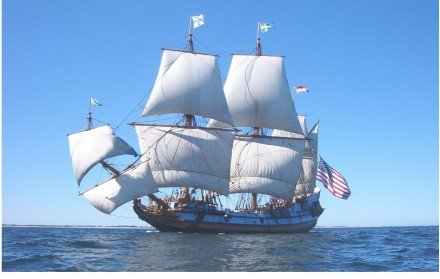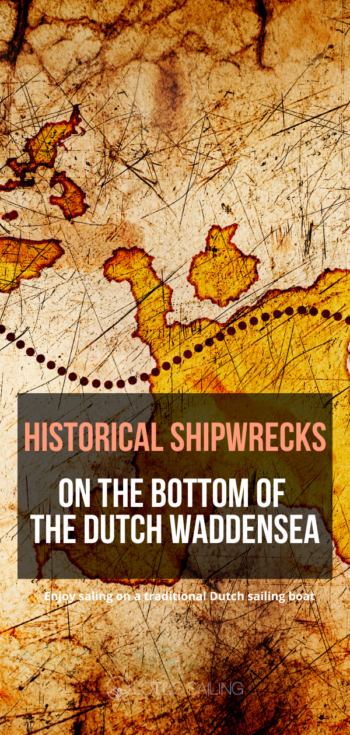The history of the many shipwrecks in the Wadden Sea
De Waddenzee is enorm rijk aan erfgoed, niet alleen in de vorm van bijzondere natuurgebieden maar juist ook door de vele schatten op de bodem van de zee.
In de afgelopen eeuwen zijn er behoorlijk wat schepen met man en muis vergaan rondom de Waddeneilanden. Dit komt omdat de Waddenzee erg beïnvloed is door de mens: Het is een van de meest bedijkte zeeën ter wereld. Dat heeft ontzettend veel invloed gehad op de stroming en dus ook op de bodem van de Waddenzee.

De vele scheepswrakken rond Texel
Vooral rond het eiland Texel bevinden zich veel historische scheepswrakken in de Waddenzee en de aangrenzende Noordzee.
Nu vergingen er overal ter wereld schepen, veel van de Verenigde Oost-Indische Compagnie (VOC) en de West-Indische Compagnie (WIC). Maar dat ze juist in de Nederlandse wateren en dan met name bij Texel ten onder gingen, had wel een reden.
De Rede van Texel
Kun je je dat nu nog voorstellen, dat “ons Texel” met zijn schaapjes en gezellige terrasjes, ooit een hele belangrijke handelspost was? Waar enorme markante schepen zoals je die nu nog ziet in films als Pirates of the Caribean, dagelijks aanlegde. met exotische handelswaar, uit alle windstreken van de wereld.
Al in de vijftiende eeuw ankerden handelsschepen uit Amsterdam en de Zuiderzeehavens bij Texel om te wachten op gunstige wind om uit te zeilen. Ze noemen zo’n ankerplaats een ‘Rede’. Dit was een relatief beschutte plaats waar schepen redelijk veilig konden ankeren.
Relatief en redelijk betekende zeker geen absolute veiligheid en dat bleek ook wel, het kon er flink stormen en er moeten tijdens deze stormen soms wel tientallen schepen per dag gezonken zijn.
Maar er kwam meer en meer overzeese handel en dus kreeg de rede van Texel steeds meer de functie van voorhaven en verzamelplaats van de groeiende koopvaardij- en oorlogsvloot. In de zeventiende eeuw lagen vaak meer dan 100 schepen te wachten om uit te varen: koopvaarders van de VOC en WIC, oorlogsschepen, walvisvaarders en graanschepen. Tijdens stormen vergingen dan ook veel van deze schepen. terwijl ze dachten veilig voor anker te liggen.

Hoeveel schepen zijn er vergaan in de Waddenzee
Schattingen aan de hand van historische gegevens komen uit ergens tussen de vijfhonderd en duizend schepen die in het gebied rond Texel moeten zijn vergaan. Dat wil niet zeggen dat er evenzoveel wrakken zijn, vooral vandaag de dag niet meer. Veel schepen werden tijdens stormen uiteen geslagen en spoelden als wrakhout op de stranden van de Waddeneilanden aan. Vaak samen met vracht, huisraad en andere waardevolle spullen. Geen wonder dat strandjutten al sinds vele eeuwen een ware levensstijl is op de Waddeneilanden.
Beroemde Scheepswrakken
Niet alle gevonden of nog niet gevonden wrakken spreken evenveel tot de verbeelding. Ook al wordt de historie van deze schepen -omgeven door vele spannende mythen- al eeuwen in stand gehouden. Er zijn nog een paar sagen die nog steeds van vader op zoon worden doorgegeven.
Het schip Aanloop Molengat
Door toeval stuitte een visser in 1984 op het wrak van een onbekend schip uit de 17e eeuw.
Het visnet van zijn boot bleef vastzitten aan wat later een houten scheepswrak bleek te zijn. Het bevond zich op 16 meter diepte, op de bodem van de Noordzee. Het wrak lag vlak bij het Molengat een stuk water tussen Den Helder en Texel, vandaar ook dat het de weinig originele naam ‘Aanloop Molengat’ meekreeg. Van 1985 tot 1999 was het gezonken schip onderwerp van de eerste onderwater opgraving van Nederland. Aan die opgravingen werkten veel enthousiastelingen mee op het gebied van onderwater archeologie. Algauw kon men een kaart maken van het schip, het bleek een behoorlijke schuit van 32 meter, met een twintigtal kanonnen aan boord.
Telkens als er nieuw ontwikkelde opgravingstechnieken werden uitgevonden werden deze toegepast en met succes. Uiteindelijk werden er ruim 3000 verschillende objecten vanuit het schip boven water gehaald.

Wanneer is de Aanloop Molengat gezonken
Door het goed te bestuderen van de lading werd uiteindelijk duidelijk dat het schip in 1635 of kort daarna gezonken moet zijn.
Het schip was namelijk geladen met onder andere luxe stoffen die afkomstig waren uit Leiden. In die tijd werden er aan balen textiel loodjes vastgemaakt waarop in dit geval het productiejaar stond gegraveerd.
Welke route voer de Aanloop Molengat voordat ze verging?
De route van dit schip kon min of meer worden vastgesteld door de lading die duikers al die eeuwen later terug vonden in het schip.
Zo werden er naast de textiel loodjes ook metalen als tin en lood aangetroffen en hesen ze pakketten runderhuiden en Ivoor uit het schip naar de oppervlakte. De samenstelling van deze goederen zegt iets over de handelsroute in die tijd.
Het tin bleek vanuit Tsjechië via Hamburg naar Nederland gebracht te zijn. De loodblokken kwamen uit Polen, het textiel kwam behalve uit Leiden, ook uit Delft en verschillende steden in België. De runderhuiden en het Ivoor waren niet verrassend terug te leiden naar Afrika.
Hierdoor ontstond het vermoeden dat de Aanloop Molengat [helaas hebben ze nooit de originele naam kunnen achterhalen] een zogenaamde ‘straatvaarder’ was. Wat zoveel inhoudt als dat het een relatief groot schip was voor zijn tijd. Het was speciaal gebouwd om via het kanaal [de straat] naar Frankrijk te varen. De lading tin en lood leek dit te bevestigen, hiervan maakten ze wapens en in die tijd lagen de Fransen behoorlijk overhoop met de Spanjaarden. Geen wonder dus dat die ladingen wapenmateriaal lieten aanrukken.
Een deel van de opgedoken lading van Aanloop Molengat is te zien in het Juttersmuseum Kaap Skil op Texel.

De Lutine
De Lutine was een joekel van een oorlogsschip van ongeveer 40 meter lang en met wel 26 kanonnen. Het werd gebouwd in opdracht van de Franse marine in 1779 in het Franse Toulon en kreeg de naam ‘La Lutine’ wat zoveel als: ‘Kwelduivel’ betekent. Nadat de revolutie uitbrak en de Fransen in de pan gehakt werden bij de slag om Toulon jaren later, waren de Franse koningsgezinde bang dat de schepen in handen van de revolutionaire zouden vallen. Ze schonken de Lutine en nog een hele vloot aan schepen, met grote haast aan de Engelse marine.
Onder de Engelse vlag werd zij verbouwd en kreeg ze nog een hele riedel kanonnen erbij, de getallen verschillen maar het moeten er uiteindelijk 38 zijn geworden. Hiermee werd het een van de paradepaardjes van de Engelse marine.
Toen er dus een heel speciaal transport besteld werd door rijke Engelsen, met een kostbare lading en een hoop hoge piefen aan boord. werd de beste kapitein van stal gehaald en de Lutine ingezet. In oktober 1799 vertrok het schip uit Yarmouth met bestemming Hamburg om daar een gigantische hoeveelheid goud en zilver af te leveren ter ondersteuning van Hamburger kooplieden die in een crisis verkeerden. Engeland leverde toen enorme hoeveelheden linnen, katoen producten en garens en deze lucratieve handel stagneerde wegens gebrek aan contanten door de grote onrust in Europa. De Engelsen zagen hun handel verloren gaan en besloten met een grote investering de Hamburgers te helpen. Echter zou deze investering Hamburg nooit bereiken.

De ondergang van de Lutine
In de nacht van 9 op 10 oktober 1799 gaat het mis, het stormt zoals het alleen op het Wad tekeer kan gaan. Ten noorden van Vlieland en Terschelling vaart de Lutine te dicht langs de kust, komt in de problemen en slaat groot alarm door alle kanonnen te laten bulderen.
Dit gaat niet onopgemerkt voorbij en er komt algauw een reddingsactie op gang vanaf de Waddeneilanden. De razende storm zorgt er voor dat de redders moeten wachten tot het weer wat rustiger wordt.
Dit duurt te lang voor de Lutine en ze zinkt. Slechts één van de 270 opvarende wordt levend uit het water gevist door een loodsboot uit Vlieland, zo gaat het verhaal althans. Wie deze persoon is, is nooit duidelijk geworden, iets dat de bank Lloyd’s in Londen heel vervelend vond. De lading was bij hen voor een astronomisch bedrag verzekerd en zonder getuige die kon vertellen wat er gebeurd was, kon de bank de schuld niet afschuiven op de kapitein en dus de marine. Maar zat er niks anders op, dan uit te betalen.
De schat van de Lutine
Omgerekend naar de waarden vandaag moet de Lutine voor vele miljoenen euro’s aan kostbaarheden bij zich hebben gehad. Het goud en zilver van de Lutine was verpakt in houten vaten, die na verloop van tijd moeten zijn open gegaan. De lading ligt verspreid op de zeebodem over een gebied dat ongetwijfeld veel groter is dan de romp van het wrak; onderzeese stromingen kunnen goudstaven van 5 kilo gemakkelijk verspreiden.
Bergingspogingen van de Lutine
Er zijn vanaf 1800 meer dan twintig serieuze berging pogingen geweest, waarbij kanonnen en andere zaken werden opgevist, maar bij slechts enkele van die pogingen zijn er daadwerkelijk goud- en zilverstaven geborgen en lang niet allemaal.
Het verloren gaan van het wrak de Lutine
Een spectaculaire bergingspoging van de Lutine, vond plaats in de zomer van 1938 met het enorme baggervaartuig Karimata van een grote mijnbouwmaatschappij. Het vaartuig was bestemd voor Nederlands Oost-Indië, maar kon mooi getest worden zo.
De bergingspoging was waarschijnlijk mede bedoeld als publiciteitsstunt voor het mijnbouwbedrijf. Het trok massa’s publiek, die maar wat graag een excursie maakten naar de Karimata. Het bergingsschip was verankerd boven het wrak en deed dagelijkse pogingen iets van de verloren schat van de Lutine boven water te halen.
Het wrak van de Lutine werd helaas door al dit enthousiasme en de graafmachines vernietigd. Er werd maar één goudstaaf naar boven gehaald – en mogelijk was die staaf nog frauduleus ook, om de publiciteitsstunt te verbeteren.
Tot op de dag van vandaag spreekt de scheepsschat van de Lutine tot de verbeelding en worden er nog ieder jaar vele pogingen ondernomen om de enorm kostbare lading van dit zeilschip of wat er van over is, te vinden.
Zelfs met de technologische kennis van vandaag is er nog geen apparatuur uitgevonden die goed genoeg is om mee in de zeebodem te kunnen kijken.
Wat zoeken naar wrakken en hun inhoud in dit gebied ook bemoeilijkt zijn de enorme stromingen die bij elke getijde door de zeegaten tussen de eilanden raast. Juist op deze plekken zijn vele schepen vergaan en juist die enorme stroming zorgt ervoor dat wrakken soms zichtbaar op de bodem liggen en even later volledig verdwenen zijn onder een dikke laag zand.
De beroemde scheepsbel van de Lutine
Tijdens de berging van 1857-1860 werden niet alleen goud- en zilverstaven gewonnen, maar ook de scheepsbel. Die Lutine Bell werd opgehangen in het hoofdgebouw van Lloyds in Londen en hangt daar tot op de dag van vandaag. Als er op geslagen wordt, betekent dat vaak een total loss van een via Lloyds verzekerd schip!
De Waddenzee en haar wrakken ontdekken op een historisch zeilschip
Wordt je hier nou enthousiast van en wil je zelf eens een kijkje nemen op de verschillende Waddeneilanden, om te zien wat ze van de Lutine en andere schepen hebben gevonden?
Bijvoorbeeld in het Wrakkenmuseum of museum het behouden huys op Terschelling.
Boek dan een zeilreis op een traditioneel zeilschip vanuit de haven van Harlingen. Ontdek zelf ter plekke de mythen achter de vele wrakken rondom de Waddeneilanden.


